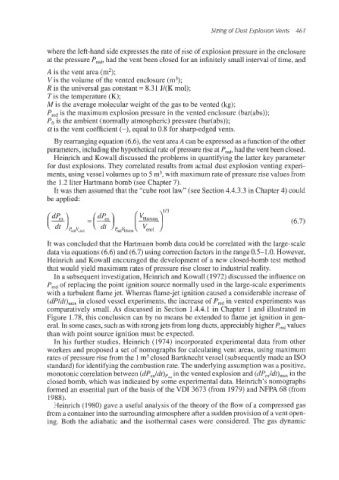Page 494 - Dust Explosions in the Process Industries
P. 494
Sizing of Dusf Explosion Vents 46 1
where the left-hand side expresses the rate of rise of explosion pressure in the enclosure
at the pressure Pred,had the vent been closed for an infinitely small interval of time, and
A is the vent area (m2);
Vis the volume of the vented enclosure (m3);
R is the universal gas constant = 8.31 J/(K mol);
Tis the temperature (K);
M is the average molecular weight of the gas to be vented (kg);
Predis the maximum explosion pressure in the vented enclosure (bar(abs));
Po is the ambient (normally atmospheric)pressure (bar(abs));
CYis the vent coefficient (-), equal to 0.8 for sharp-edgedvents.
By rearrangingequation (6.6), the vent areaA can be expressed as a functionof the other
parameters,including the hypotheticalrate of pressure rise at Pred,had the vent been closed.
Heinrich and IKowall discussed the problems in quantifying the latter key parameter
for dust explosions. They correlated results from actual dust explosion venting experi-
ments, using vessel volumes up to 5 m3,with maximum rate of pressure rise values from
the 1.2 Biter Hastmann bomb (see Chapter 7).
It was then assumed that the "cube root law" (see Section 4.4.3.3 in Chapter 4) could
be applied:
It was concluded that the Hartmann bomb data could be correlated with the large-scale
data via equations(6.6) and (6.7) using correction factorsin the range 0.5-1.0. However,
Heinrich and Kowall encouraged the development of a new closed-bomb test method
that would yield maximum rates of pressure rise closer to industrial reality.
In a subsequentinvestigation,Heinrich and Kowall(l972) discussed the influence on
Pred of replacing the point ignition source normally used in the large-scale experiments
with a turbulent flamejet. Whereas flame-jet ignition caused a considerableincrease of
(dP/dt),, in closed vessel experiments, the increase of Predin vented experiments was
comparatively small. As discussed in Section 1.4.4.1 in Chapter 1 and illustrated in
Figure 1.78, this conclusion can by no means be extended to flame jet ignition in gen-
eral. In some cases, such as with strongjets from long ducts, appreciably higher PIzdvalues
than with point source ignition must be expected.
In his further studies, Heinrich (1974) incorporated experimental data from other
workers and proposed a set of nomographs for calculating vent areas, using maximum
rates of pressure rise from the 1m3closed Bartknecht vessel (subsequently made an IS0
standard)for identifyingthe combustion rate. The underlying assumption was a positive,
monotonic correlationbetween (dPex/dt)prdin the vented explosion and (dP,,/dt),, in the
closed bomb, which was indicated by some experimental data. Heinrich's nomographs
formed an essential part of the basis of the VDI 3673 (from 1979) and NFPA 68 (from
1988).
Heinldch (1980) gave a useful analysis of the theory of the flow of a compressed gas
from a container into the surrounding atmosphereafter a sudden provision of a vent open-
ing. Both the adiabatic and the isothermal cases were considered. The gas dynamic

